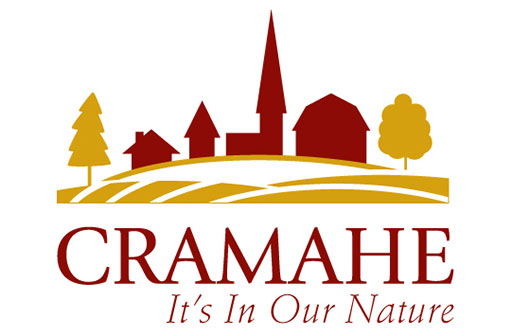7 Victoria Street, Colborne
(c.1860 – 1890s)
Roll No. 1411-012-020-16100 – Cramahe Township Ontario

Folk Victorian
No. 7 Victoria Street is in a part of the village of Colborne, quite near “the Dairy” which is now a residence at No. 11 Victoria Street. Records indicate that the jail of the 1800s was built just south of No. 7, indicating the area was commercial at one time.
This is an excellent example of the red brick “Folk Victorian”.
Drawing on today’s standards, you would think that the use of brick on No. 7 would indicate the builder of this house was more affluent than some of the builders of the clapboard Folk Victorians, but we cannot jump to this conclusion because both building materials were abundant in the mid to late 19th century, so it is difficult to know what led to each choice.
No. 7 is the only century old red brick Victorian with an address on the East side of Victoria Street. It matches the Folk Victorian profile very well, with the exception of the closed in porch which was probably a later addition. The gable end faces the street with a crossed gable roof the “L” shaped wing which defines the Folk Victorians. At ground level, there is an unusual and unique bay window with two panes of glass on the facade and one on each side of the bay.
There are decorative painted keystones on top of each window and the actual windows are two over two pane with round head sashes. There is a clapboard addition on the rear of the building, and a rubble foundation under the brick part of the house which places it in time with many of the other Victorian houses built in the latter half of the 19th century.
History or Associative Value
Arnold Warren, bush pilot, veteran, long time Colborne resident and amateur historian, wrote a first person ‘word picture’ of a walk around downtown Colborne in 1919, for the Colborne Chronicle’s 125th edition (the local newspaper of the era). “Prior to this” he wrote, “the Village Jail, called the “black hole” was just south of my boyhood home at 7 Victoria Street”.
It is thanks to Arnold that so much is known of Colborne at the turn of the century as he was a keen observer of life and lifestyles.
Additional Historical and Genealogical Information
Although the Clergy reserve system wasn’t to end until 1854, the northern half of Lot 31, including all of the land in the reserve that is now part of Colborne, was granted by the Crown to Joseph Abbott Keeler (1788-1855) (LINK) on 12 April 1842. Keeler passed most of his properties, including Reid Lot 224, to his son Joseph Keeler III (1824-1881) on 23 September 1854.
Keeler sold Reid Lot 224 to Sarah Yeomans (1824-1898) on 21 February 1880. Sarah was the wife of Colborne livery stable owner John Luke Yeomans (1826-1904), whose stable was just a short distance away, where the Post Office now stands.
Sarah Yeomans’ maiden name was Palmer and she was a granddaughter of early Cramahe settler George Asahel Palmer (1761-1833). She and John Yeomans had seven children: Bennett (1849-1865), Caroline A. (1852-1881), John Stephen (1858-1908), Louise (1858-?), Albert E. (1861-1890), Frederick (1866-?), and Florence L. (1871-1871).
On 18 July 1882 Sarah Yeomans sold Lot 224 to her daughter-in-law Annie Yeomans (née Kernaghan, 1860-?). Annie’s husband was John Stephen Yeomans who, like his father, was a liveryman. Reference has been found to a single child: George S. (1883-1894).
Annie Yeomans and her husband sold Lot 224 to David Morris Wright (1807-1894), a “gentleman” from Haldimand Township, on 19 November 1891. After Morris died the property went to the Presbyterian Church on 20 January 1897. The Church sold it to Jane Sophia Canner (?-1912) on 7 October 1903.
Little has been found about Jane Canner. She was listed in land records simply as a spinster and she died in 1912 of a cerebral hemorrhage. Although land records and her death record list her place of residence as Colborne in 1903, 1911, and 1912, she seems to be absent from the 1911 census.
Jane Canner sold Lot 224 to Ellen Reive (1846-1924) on 15 July 1911. She was the wife of John Reive (1840-1931), who at various times was a butcher, a dealer in agricultural tools and machinery, and a bailiff. The spelling of their surname is unclear: records variously list it as Reives, Reeves, Rieves, Reive, Reeve, and Rieve. Reference to as single child has been found: Anna (1870-?). Ellen Reive was born Ellen Bellamy and was the daughter of Chauncey Bellamy (1809-1889). This means that she grew up in the house at 14116 Highway 2 (LINK). She died in 1924 of heart failure.
On 14 May 1912 Ellen Reive sold Lot 224 to William Bassett Warren (1883-1917), a Colborne baker. On 16 March 1915 Warren transferred the property to his wife Anna Ethel Button (1884-1966), who retained it through 1921. Two children are listed in censuses: Arnold W. (1908-2000) and Mabel Gladys (1912-?).
Sarah Yeomans bought Lot 224 in 1880 from Joseph Keeler for $150 and sold it to Annie Yeomans in 1882 for the same amount. Nine years later (1891), Annie Yeomans sold it to David Wright for $800. Wright donated the property to the Presbyterian Church in 1897 and the Church sold it to Jane Conner in 1903 for $600. Conner sold it to Ellen Reive in 1911 for $650 and Reive sold it to William Warren in 1912 for $1500. Warren gave it to his wife (“natural love and affection and $1”) in 1915. Two jumps in price are apparent, and one of them may reflect the addition of a house to the property: between 1882 and 1891, and between 1911 and 1915.




